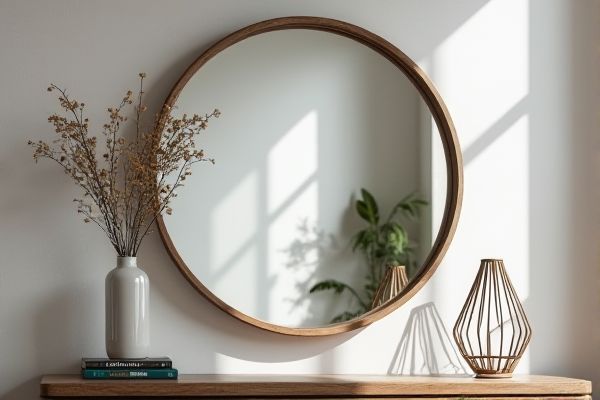
Framed mirrors offer a decorative border that enhances your space with style and protection, while frameless mirrors create a sleek, modern look that expands the room visually. Discover which mirror choice best suits Your design needs by reading the rest of the article.
Table of Comparison
| Feature | Framed Mirror | Frameless Mirror |
|---|---|---|
| Design | Has a visible border or frame, often decorative | No border, sleek and minimalist appearance |
| Installation | May require brackets or hooks for frame support | Usually mounted directly on the wall with clips or adhesive |
| Durability | Frame protects mirror edges; more resistant to damage | Edges more exposed; requires careful handling |
| Customization | Frame styles vary widely - wood, metal, plastic | Limited to mirror shape and edge finish only |
| Maintenance | Frame may collect dust; requires regular cleaning | Easier to clean, fewer crevices |
| Cost | Generally more expensive due to frame materials | Typically less expensive |
| Style Fit | Traditional, classic, or ornate interiors | Modern, minimalist, contemporary spaces |
Introduction to Framed and Frameless Mirrors
Framed mirrors feature a decorative border that enhances the overall aesthetic and complements your room's style, providing structure and visual interest. Frameless mirrors offer a sleek, minimalist look with a clean edge, ideal for creating an open and modern space that reflects maximum light. Choosing between framed and frameless mirrors depends on your design preference and the ambiance you want to achieve in your home or office.
Design Aesthetics: Framed vs. Frameless Mirrors
Framed mirrors offer a distinct design aesthetic with their versatile borders that can complement traditional, rustic, or modern decor by adding texture, color, and structure to your space. Frameless mirrors create a sleek, minimalist look, emphasizing clean lines and reflecting more light, which enhances a sense of openness and modernity. Your choice between framed and frameless mirrors depends on whether you want a decorative accent or a subtle, unobtrusive reflective surface.
Material and Build Quality Comparison
Framed mirrors typically feature a sturdy wooden, metal, or plastic frame that enhances durability and offers protection to the mirror edges, making them less prone to chipping or cracking. Frameless mirrors are crafted from high-quality tempered glass with polished or beveled edges to reduce sharpness, relying on their thickness and precision cutting for structural integrity. Both mirror types prioritize premium materials, but framed mirrors provide extra reinforcement through their surrounding structure, while frameless mirrors emphasize sleek design with robust glass construction.
Durability: Which Option Lasts Longer?
Framed mirrors often provide enhanced durability due to the protective border that shields the edges from chipping or damage, extending the mirror's lifespan. Frameless mirrors, while sleek and modern, have exposed edges that can be more susceptible to cracking or breaking over time, especially in high-traffic areas. For long-term use, framed mirrors typically offer greater resilience and better edge protection compared to frameless designs.
Installation Differences and Ease
Framed mirrors typically require wall anchors or hooks for secure mounting, making installation straightforward but sometimes more time-consuming due to weight and frame bulk. Frameless mirrors often need specialized adhesive or mounting clips, offering a cleaner look but demanding precise alignment and surface preparation. Ease of installation varies with frameless models being lighter yet more delicate, whereas framed mirrors provide stability but can be heavier to handle.
Maintenance and Cleaning: What to Expect
Framed mirrors typically require regular dusting and careful cleaning to avoid damaging the frame material, which can be made from wood, metal, or plastic, each needing specific cleaning agents; glass cleaner works well for the mirror surface itself. Frameless mirrors have simpler maintenance since they lack edges that collect dust or grime, making it easier to clean the entire surface with a microfiber cloth and a gentle glass cleaner. Both types benefit from avoiding abrasive cleaners to prevent scratches and maintain a clear reflection over time.
Cost Comparison: Framed vs. Frameless Mirrors
Framed mirrors generally cost more due to the materials and craftsmanship involved in creating the frame, with prices varying based on frame style and quality. Frameless mirrors are typically more affordable as they require less material and simpler installation, making them a budget-friendly option. The overall cost difference can range from 20% to 50%, depending on size, thickness, and customization options.
Customization and Design Flexibility
Framed mirrors offer extensive customization options with various materials, colors, and styles to complement specific interior designs, providing a tailored aesthetic appeal. Frameless mirrors enhance design flexibility through their minimalist, sleek appearance, allowing seamless integration into modern and contemporary spaces without visual interruption. Both offer versatility in size and shape, but frameless mirrors provide a more open, spacious feel, while framed mirrors add defined character and texture.
Suitable Applications in Home Décor
Framed mirrors are ideal for traditional, vintage, or rustic home decor styles, providing an accent that enhances the overall aesthetic and adds depth to living rooms, bedrooms, and entryways. Frameless mirrors offer a sleek, minimalist look perfect for modern, contemporary, and small spaces such as bathrooms and galleries, where a clean, unobtrusive reflection is desired. Both types serve functional and decorative purposes, with framed mirrors often acting as statement pieces while frameless mirrors emphasize spaciousness and light.
Which Mirror Type Is Right for You?
Choosing between a framed mirror and a frameless mirror depends on your style preferences and room decor. Framed mirrors offer a defined border that can complement traditional or ornate interiors, while frameless mirrors provide a sleek, modern look that enhances spaciousness. Your decision should consider the desired visual impact and maintenance requirements, ensuring the chosen mirror suits your functional and aesthetic needs.
 homyna.com
homyna.com